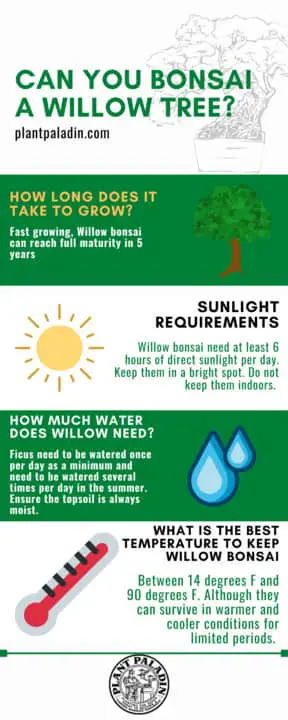This website is supported by its readers. If you click one of my links I may earn a commission. I am also a participant in the Amazon affiliates program and I will also earn a commission from qualified purchases.
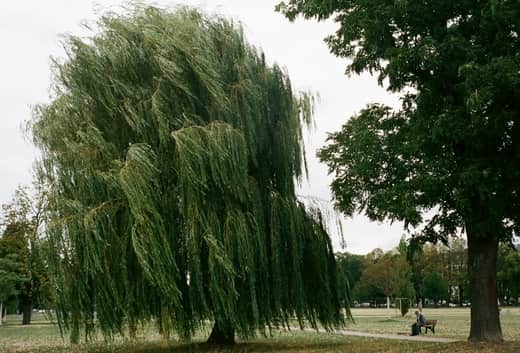
Willow trees are amongst one of the most popular tree species in the world. With an estimated 400 different species these trees can be found in north and south America, Europe, and Asia. With bonsai surging in popularity and with more people working from home, naturally, there is a lot of room for a crossover with the art of bonsai. So can you bonsai a Willow tree?
Willow tree species make for fantastic bonsai trees. Weeping Willow in particular is a fantastic-looking bonsai due to its long-flowing leaf canopy. These trees however are very fast growing and so require a lot of maintenance.
So how exactly do you care for Willow bonsai trees? And what are the advantages and disadvantages of this tree species? Keep reading to find out more.
Just a quick heads up, over the past three years of running Plantpaladin, hundreds of people have asked for product recommendations. As such, You can find my favorite indoor bonsai tree here (link takes you to Bonsaiboy), my favorite outdoor bonsai tree (link takes you to Bonsaiboy), or have a look at all the products I recommend here.
Can You Bonsai A Willow Tree?
Willow trees, whilst not as popular as ficus, junipers, or elms, are becoming more and more commonplace in bonsai keepers nurseries and greenhouses.
Its long flowing leaves and over 400 varieties make it very easy to find and cheap to maintain.
That being said, there can often be a lot of conflicting evidence around how to plant, grow, and maintain this very particular bonsai.
As such, this past year, I attempted to grow my own weeping Willow bonsai tree, got in touch with a few experts, and even asked 10 of my fellow plant paladin readers how to grow this species.
Hopefully, this has meant giving you the most up-to-date accurate article on the web around growing Willow bonsai trees.
To summarize:
Can you bonsai a Willow tree:
Willow bonsai tree requirements | Explained |
Water | Water once per day in the spring, only if the soil is dry to touch, During the summer and hot conditions watering several times a day will be required. Use moisture trays or place your pot in a bowl of shallow water to prevent it from drying out. Water once per week in winter as a rule of thumb. |
Sunlight | Direct sunlight for 6 hours per day during the spring and summer. Place in the shade/semi-shade during the brightest weeks of the year. |
Temperature | Between 14 degrees F and 90 degrees F. Although they can survive in warmer and cooler conditions for limited periods. |
Fertilizer | Fertilize with organic fertilizer once every 6 weeks. Use liquid fertilizer once every 2 weeks during the spring and summer. Avoid fertilizing during the winter. |
Repotting | Once to twice per year |
Placement | Outdoors during the spring, summer, and fall, indoors during the winter in cold climates. |
Species Type | Deciduous |
Wire type | Both copper and aluminum |
Time to grow from seed | 5 years |
Potting Soil | Inorganic mix of akadama and volcanic ash rock |
Groth type | Fast-growing, adding 12-36 inches of growth per year |
Size | Medium to large, most trees sold are typically two hand bonsai |
Lifespan | 50 to 100 years if used for bonsai (30 to 50 years if not used for bonsai) |
Pests | Willow borer, aphids, scale, caterpillars, gall makers, gall mite are commonly effect willow |
Fruit | Produce valve-like capsules however they are not palatable. |
How often should you water a Willow tree?
So first up will be the activity you will be doing the most when it comes to growing and maintaining a Willow bonsai tree – the watering.
Willow bonsai tree species as a minimum should be watered once per day during the spring. Willow bonsai should be watered several times per day during the summer. The topsoil of this tree should be kept moist. Watering once to twice per week in the winter will be adequate.
Whilst all bonsai trees require watering, Willow trees, due to their flowing leaves often have to be watered a lot more than other bonsai species.
On most days, (spring and summer) once per day will be fine, just ensure you touch the topsoil.
If dry to the touch, your Willow tree will need water – aim to ensure the topsoil of Willow bonsai is always moist to touch.
As a rule of thumb, however, try to ensure the topsoil of your Willow does not dry out.
During the summer more watering will be required – potentially up to 3 times per day.
The larger leaves will have more water needs than other plants and will easily dry out if not cared for adequately.
What water should I use for my Willow?
Tap water can be used when watering a Willow tree however excess usage of tap water can cause a build-up of fluoride in the soil and can change the PH level of the soil.
I prefer to use rainwater which contains small levels of essential nutrients that treated tap water will not have.
What should I use to water my Willow bonsai?
Using a watering can will be adequate for a small or medium-sized Willow bonsai.
Ensure you water from high up covering both the leaf canopy and the soil.
For larger trees, using a hose or pressure washer can be used.
During the summer, consider filing moisture tray or bowl full of water and placing your bonsai pot in that water.
This will give a consistent supply of water when your tree will need it the most.
This will help prevent dry roots, and branches and will prevent drought-like conditions.
If you have overwatered your bonsai tree, consider reading this post.
Sunlight requirements for Willow tree bonsai
Willow bonsai, regardless of sub-species require a lot of direct sunlight. Aim for these species to be exposed to full sun and get at least 6 hours of direct sunlight every day. In the summer, they can be moved into the shade to avoid burning.
So like most tree species used for bonsai, Willow trees prefer a lot of sunlight.
In ideal conditions, you should aim to get direct sunlight in full shade for at least 6 hours per day.
In summer this can be reduced to 4 hours of direct sunlight with the remainder of its time in the shade.
The best placement for Willow bonsai trees will be in a bright spot in a garden.
I’d avoid growing these trees indoors as they often grow too large and the use of LED grow lights won’t be viable for the size of these trees.
Temperature requirements for Willow tree bonsai
Willow bonsai thrive in most temperatures and can be grown from 14 degrees Fahrenheit (-10 degrees C) to 90 degrees Fahrenheit (32 degrees C) very easily. Should temperatures reach higher than this they will need to be placed in the shade.
Now if temperatures drop below this, then some form of winterizing the tree will be required – Especially if the tree is grown in a shallow bonsai pot.
For best results during the fall and the winter, either cover with mulch to prevent dehydration or keep in a cold garage or temperature monitored greenhouse.
Cold frames can also be used as a way of mitigating harsh cold winters.
That being said, Willow bonsai tree species and Weeping Willow bonsai, in particular, are very hardy trees, being able to be grown in USDA hardiness zone 4-8.
What countries have the best temperature for Willow bonsai trees?
Luckily, as Willow trees and all their subspecies are grown in almost all countries and continents they can be grown universally.
To be more specific the following continents should have no issue in growing Willow bonsai trees outdoors:
- All of Europe
- North America
- South America
- Asia
- Oceana
Countries/continents however where you may need to consider keeping your Willow in the shade however due to excessive temperatures include:
- Africa (both northern Africa and sub-Saharan Africa)
- Australia in the summer
- India, Pakistan, and Bangladesh in the summer
- The Middle-East.
Finally, whilst Willows are hardy for most countries, they can still freeze, even if winterized correctly, as such, I would double down on things like cold frames in the following countries:
- Northern Canada
- Russia
- Finland
- Greenland
Fertilizer requirements for Willow bonsai
Willow tree bonsai should be fertilized once every 6 weeks with organic fertilizer and once every 2 weeks with liquid fertilizer. Fertilizer should only be applied during the growing season. Avoid fertilizing Willow bonsai in the fall and winter.
I’d also avoid fertilizing your Willow bonsai if you have just newly planted the seeds/cuttings.
What is the best fertilizer for willow bonsai?
Any good fertilizer for Willow tree bonsai has three good elements:
- Nitrogen
- Potassium
- Phosphorous
As such, having an NPK ratio with an even distribution of all of these ( a ratio of 10-10-10 works best for me) is vital.
I’d also avoid using a fertilizer that has more nitrogen content.
This is because higher nitrogen levels in the fertilizer can cause larger leads and internodes which are particularly attractive to pests like aphids and scale.
What about liquid fertilizer?
Liquid fertilizer can also be used for Willow bonsai trees.
Aim to use a liquid fertilizer that also contains a balanced mix of the above elements, but also one that you can pour easily into the cap of the fertilizer cap – making measurements easy.
Liquid fertilizer has a bunch of other benefits such as having built-in pesticides, being easier to be absorbed directly into leaves and roots.
They are also often concentrated making for much stronger, faster growth for Willow trees.
This however can be a double-edged sword with Willows already being notoriously fast-growing tree species.
Where to place willow bonsai?
Willow bonsai should only be placed outdoors. This is because the tree species is very fast growing and will be too large to be grown indoors or in a space without a garden such as a nursery. Place in the brightest spot in your garden during the spring and summer.
During the fall and winter, these trees can be left outdoors as they are hardy.
Just be sure to winterize them by using mulch to prevent the trees from drying out.
What if I want to keep my Willow bonsai tree indoors?
Willow bonsai trees should not be kept indoors.
If however, you are adamant about growing this tree indoors, ensure you have a large enough space in your home to do so.
Place in front of a window that gets plenty of sunlight or use multiple grow lights to meet the tree’s requirements.
Just know that growing Willow bonsai indoors will be detrimental to its health and its lifespan may be severely diminished.
Consider instead investing in a bonsai tree that can be easily grown indoors such as a ficus or elm variety.
How long does it take to grow a Willow bonsai from a seedling?
Willow bonsai trees are a fast-growing bonsai species and can reach full maturity in five years. These species can also be trained from very early on in a year or so can be propagated very easily.
Willow bonsai then is easily one of the best bonsai tree species to consider opting for if you decide to grow this tree from scratch.
Can you grow a Willow bonsai from a cutting?
As willow bonsai are very fast growing they are very easy to grow from a cutting. Aim for cuttings to be about 6 to 8 inches long and have the same thickness as a pencil for best results. Cuttings do not need to be plated in solid and will sprout roots in water.
How to grow a Willow bonsai tree?
So now you know that these tree species can be grown very easily from both a seed and a cutting, what is the exact step-by-step process of growing a Willow bonsai tree.
As you can imagine, this is a very specific process which is why I’ve come up with posts on the topic of both seeds and cuttings here.
To summarize, however:
Ensure it’s the right time of year
So first up on the journey of planting your Willow bonsai tree is just ensuring that it is the right time of year.
One of the major benefits of Willow bonsai being widely available and native to most continents is that it grows pretty much in the same seasons year-round.
As such, these trees will benefit from being planted in the early spring, regardless of if you are using seeds, seedlings, or cuttings.
Now if you live in a climate where Willows are sadly not native then you will need to undertake the additional step of scarification and stratification.
Decide on the style of your Willow bonsai tree
As Willow bonsai are so fast-growing, deciding on the size and style of tree you are going for early on will save you countless hours of heartache later on.
Often the decisions you make during the planting stage will impact the overall look and design of your tree.
As such, make a note of the style of bonsai tree you want to opt for.
Bonsai trees come in a variety of styles including but not limited to cascade, upright informal, and sumo.
These all require different training techniques to achieve the desired look such as trunk splitting or trunk development.
As such, draw out a rough idea of how you want your Willow bonsai to look on a piece of paper to give you something to aim for.
This can always be changed a few months down the line but having something to aim for will work wonders during the growing process.
Decide on the size of your Willow bonsai
Similar to coming up with the style of your bonsai, you also need to take note of the size of your tree.
Bonsai trees fall into different size classifications depending on if you would like to compete in competitions.
These size classifications are commonplace and are the most common sizes trees are kept to.
As Willows are so fast-growing, if you want to keep a smaller-sized bonsai tree such as a fingertip or a one-hand bonsai, there will be a lot more work required.
Willows are often the opposite of a lot of bonsai species which can take years if not decades to grow to the right size.
Seeds VS Cuttings
So you’ve laid the groundwork, understood that it’s the right time of year, and decided on the size and style of your tree.
Next up is one of the big decisions you have to make.
Do you opt for bonsai seeds or bonsai cuttings?
My recommendation would be to use cuttings for Willow bonsai. This is just because Willow cuttings are very easy to propagate and don’t even need soil to start producing roots.
Using seeds may just complicate the process for no reason.
On top of this, unlike other seeds, Willow seeds are different in the sense that they’re kept in a capsule and when the time is right, flow away like dandelions making the process a lot more difficult to propagate from seed.
Cuttings are also much easier to take than buying store-bought Willow seeds.
That being said I will cover how to grow Willow bonsai using both methods to make sure the post is comprehensively covered.
Benefits of using Willow seeds
The main benefit of using Willow seeds are:
- Relatively inexpensive – These seeds are very common and so can be purchased for a few dollars
- Propagate easily – These seeds will germinate within 24 to 48 hours of touching moist soil.
- Different species – Whilst Weeping Willow bonsai are the most common types of trees, if you want a different Willow variety that is harder to come by in your country, you can find these online
Drawbacks of using Willow seeds
- Time – Using seeds can take longer than it would take to grow a bonsai tree using a cutting by a few months.
- Not easy to gather – These seeds are not easy to gather from scratch, as they can be easily blown away.
- Pests – Birds, Squirrels, and other small animals love to pick at seeds making it much easier for these to be dug up by pests.
Benefits of using Willow cuttings
- Speed – Using a cutting as opposed to seeds can speed up how large your tree grows by a few months
- Less chance of pest attack – As cuttings are larger than seeds, they won’t risk getting dug up by pests.
- No need for soil – Cuttings like seeds for Willow bonsai do not need soil and can instead grow roots in water.
Drawbacks of using Willow cuttings
- Fast repotting – Willow cutting will need repotting every few months to maintain their growth when compared to seeds which won’t need repotting for about a year.
- Your skillset – By using cuttings you are missing out on the process of growing a bonsai tree entirely from scratch which many bonsai owners feel is a badge of honor.
Let’s dive into growing your Willow bonsai with seeds first.
Using seeds
So if you have decided to opt down the path of using seeds to grow your Willow bonsai, you will need to purchase your seeds.
This can be undertaken in 3 main ways:
- By them from a local retailer
- Purchase them online
- Pick them yourself for free
Buying Willow seeds from a local retailer has the benefit of knowing the seeds you buy, will not need any further steps to help them propagate as they will have been grown in the same climate as where you live.
Another viable option will be purchasing your seeds online.
Willow seeds come in hundreds of sub-species and so if you want to purchase a specialist Willow tree this might be the best option for you.
Finally, the cheapest and easiest method is just to pick Willow seeds yourself.
To do this, collect the seeds when they are still encased in a capsule
Then move them into a clear plastic ziplock bag and keep them moist.
When the capsules open the seeds will disperse.
You can then pick one and plant it in moist soil and the seed will start to propagate.
Bonsai a Willow tree from cuttings
As mentioned, while it is possible to grow a Willow bonsai tree from a seed, it just isn’t viable for a lot of us due to the nature of the seeds.
The best option then in my opinion would be to use cuttings.
One of the best things about Willows is that it’s not just small cuttings that will propagate but large cuttings as well.
To start then.
Make a cutting at a 45-degree angle
First up, get your existing Willow bonsai tree, and using a pair of bonsai shears or other bonsai accessories make one clean cut sharp cut on one of the branches.
Cutting this at a 45-degree angle will further help the new cutting gain roots (although as Willows are very easy to propagate even straight cuts will work).
For best results, make your cutting just above a node on the branch you have selected and just underneath a second node.
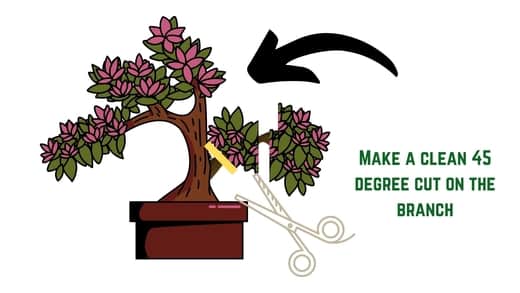
This will give you additional cuttings if you decide to grow more Willows later on.
The cutting should also be about 6 to 8 inches long for best results and about 1 to 2 cm wide for best results.
Remove any excess leaves
Next up, simply use a pair of scissors and remove any excess leaves or growth the cutting may have.
This includes this such as secondary or tertiary branches from the Willow until you have a clean thin long Willow.
Fill a mason jar with water
Unlike other bonsai tree species, this is where things start to divert for Willow bonsai.
As Willows are very easy to propagate you don’t need to use a propagator or even plant the cutting in the soil to generate roots.
No rooting hormone or powder needs to be used either.
Instead, simply fill up a mason jar with 2 to 3 inches of tap water (rainwater can be used too)
Then place the cutting in the jar with the nodes facing upwards.
Keep the top of the mason jar open and keep it at room temperature in a bright spot in your house.
I find that a window sill works best for this.
After a week the Willow will be ready to move into its new pot.
Get your pot ready
While you can use a traditional bonsai pot for this, at this stage I would recommend using something like a yogurt pot in the first few months of your Willows growth.
This is because Willows grow incredibly fast and will need to be repotted in a few months.
If you decide to use a yogurt pot, ensure it has enough drainage holes depressing on the size of your cutting.
Simply use a drill or carving knife and cut the holes in the bottom of your pot.
Add your potting soil
We will touch on the specifics of the best potting solid for Willow trees a little later in the post but to summarize, any good spotting soil can be used for Willow.
I like to use an even mix of akadama and volcanic ash rock.
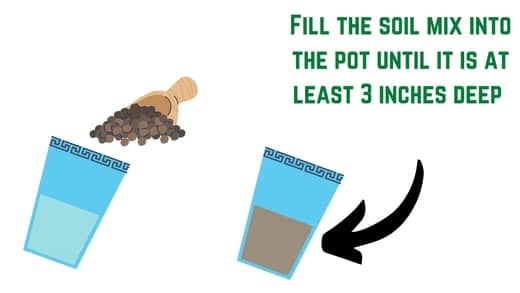
Simply fill your pot then with the soil and create a small hole in the center of the soil where you can place the cutting. This hole should be about 4 inches deep.
Add your cutting to the soil
Once your cutting has sprouted new roots, you can place them in the potting soil.
Simply apply in the indented hole you have made in the soil and over with more topsoil so the tree does not move.
A good rule of thumb is to cover half of the cutting in the soil – this should give you an idea of how deep the hole in the soil should be.
Then move outdoors into direct sunlight and get the benefits of the growing season.
After about 6 months the cutting and its roots will have grown rapidly and you will need to repot your tree.
How often should you repot a Willow tree bonsai?
Willow bonsai trees should be repotted at a minimum once per year. Most Willows less than five years need to be repotted twice per year. Bonsai trees older than 5 years can be repotted once every 2 years. Willow bonsai are fast-growing and so need to be repotted more often than other species.
How to repot a Willow bonsai
As mentioned Willow bonsai are amongst the fastest growing bonsai tree species out there.
It’s only natural then that these trees have to be repotted more often than other species.
Now repotting bonsai and managing the aftercare of repotting a bonsai tree are large topics all unto themselves but to summarize:
Remove your Willow from its pot
Use an accessory such as a root hook or other pruning tool to listen up the soil around the edge of your bonsai tree.
This will keep the roots of your tree together and make it easy to take out your tree.
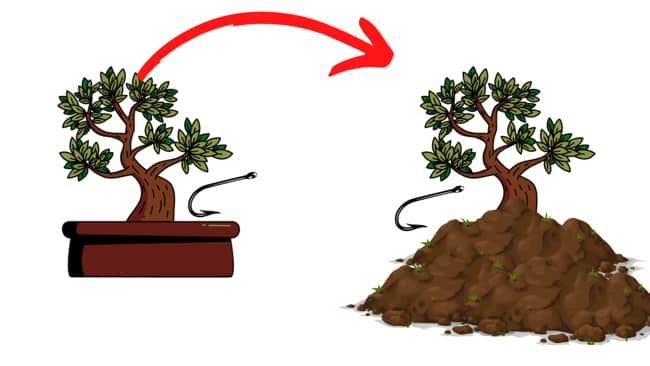
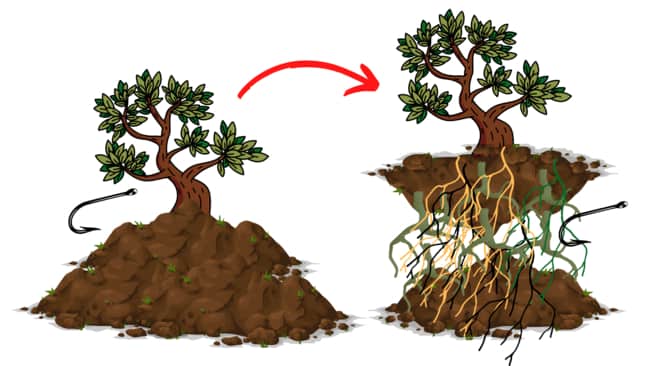
Remove any excess roots
As Willow trees grow very fast you will likely have a lot of tough excess roots.
These roots need to be trimmed down.
Use a sharp pair of scissors and trim these roots down – including feeder roots.
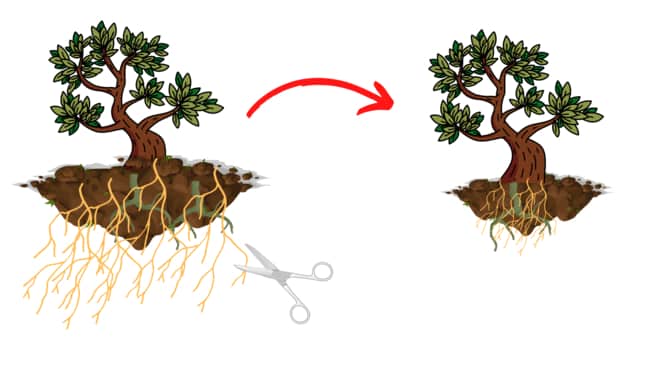
Prepare your pot
As mentioned earlier when we covered using cuttings to grow a Willow tree bonsai, now would be the ideal time to move from the yogurt pot or your first pot into a shallow bonsai pot.
First, ensure your pot has enough drainage holes for the size of your tree.
Then add a mesh to the bottom of these holes to help with moisture flow and to prevent material from passing easily through the tree.
Finally, add two lengths of copper wire through the mesh which will be used as an anchor to hold the tree in place.
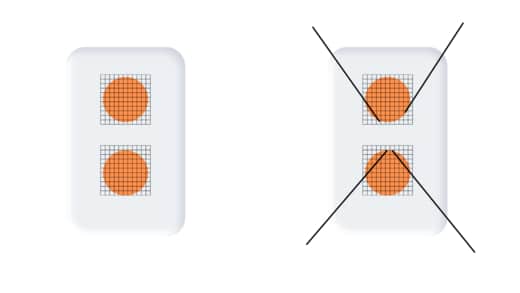
Add a base layer of soil
Similarly to adding soil for the cutting, fill the pot with the potting soil of your choice until about half full.
Then add a hole in the middle where your root structure will go.
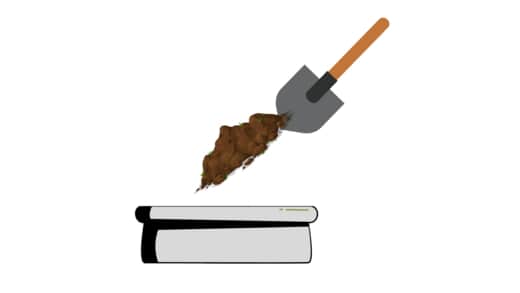
Plant your bonsai
Finally, add your tree in place in the hole and cover with topsoil until you have a smooth top and can no longer see the roots of the tree.
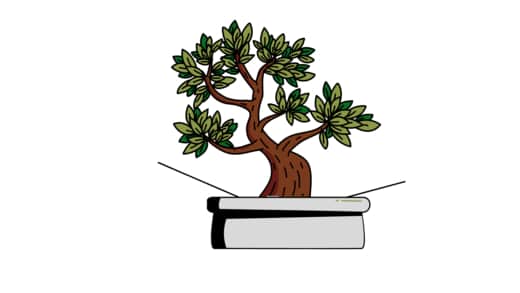
Use the wire you threaded through the mesh earlier to secure the tree in place.
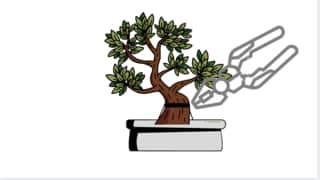
This can be done by tying the wire around the trunk of the Willow tree bonsai.
Use correct aftercare
Once the tree has been repotted – it’s important to add water and move into direct sunlight.
Regular aftercare should be undertaken as your tree will be weakened during the state of repotting.
To read up more on adequate aftercare check out this post here.
How to train the trunk of a Willow bonsai?
So once you have repotted your bonsai tree it is likely you will move on to training your bonsai tree.
This typically consists of three main methods:
- Developing the trunk of your tree
- Wiring your tree
- Regular pruning and trimming
Developing the trunk of your tree should be your first port of call and will transform a thing skinny-looking trunk into a more traditional thick-looking bonsai trunk.
How do you develop the trunk of a Willow bonsai?
Willow trunk development is most commonly undertaken with the following three methods, again these are all fairly complex processes themselves so I would read up the separate posts I have for them. :
- Growing a sacrifice branch – This is the process of growing out a branch without trimming it for a few years. This will add significant width to the trunk of your Willow bonsai.
- Trunk chopping – Removing the top half of the trunk of your tree will force your tree to grow a taper which is ideal for bonsai styles that have a wide bottom trunk and a thin top trunk such as sumo.
- Trunk bend – to add bends in the trunk of your tree, for styles like a cascade or informal upright, remove chinks of the trunk and then force them closed to add movement to the trunk.
All in all this process will traditionally take a few years on most bonsai species.
That being said, with Willows growing so fast, good trunk development can be completed in as little as 2 years.
What is the best wire for a willow bonsai?
Both annealed copper and anodized aluminum wire can be used to wire a Willow bonsai tree. This is because Willows are hardy and have thicker branches and trunks that can take a lot of damage. Raffia too can be used to help the wiring process.
How to wire a Willow bonsai tree
Once you are happy with how the trunk of your Willow bonsai has developed. I would suggest moving on to wiring the bonsai.
Wiring is essential for creating the exact style and looks you want to achieve in your tree.
Willows are different in the sense that because they are so fast-growing, they can be wired and styled very easily.
Aim to wire Willow bonsai in the early summer when shoots first start to appear around June.
This will make it easier to bend and adjust the tree throughout the growing season.
Now wiring, as a lot of things in bonsai keeping, is a complex process.
To summarise, however:
Cut your wire to size
Aim for the wire you select to be about 1/3rd the size of the thickness of the branch you will be wiring.
To test if the wire you have selected is thick enough, push it against the branch.
If the branch pushes the wire more than the wire pushes the branch then you need a thicker wire.
The wire should also be about 30% longer than the length of the branch if using the single wiring technique and 50% longer than multiple branches if following double wiring.

Wrap your wire around the trunk of your tree
Aim for this to be undertaken at a 45-degree angle.
A good rule of thumb will be to wrap this around 2 or 3 times for a good anchor point.

Double and single wire your Willows branches
It is now time to wire your branches.
This falls into two main categories; double wiring and single wring.
Single-wiring is the most common type of wiring – you will simply use one wire to wrap one branch at a 45-degree angle.
This method is also used for the smaller secondary and tertiary branches with smaller wires.

Double wiring is undertaken on two branches that are nearby each other.


Double wiring can be more effective at leveraging other branches to move heavier, sturdier branches.
Move the branches into position
Once wired, simply move the branches into the position you would like them to move in.
Branches typically can be moved up or down or clockwise and anticlockwise.
If you fear your Willow branch might break, use raffia as a substitute to help lubricate the branch.
Remove the wire after a month
After a month, the will branch will have moved into their new potion.
Use a pair of shears to cut the wire.
Avoid using your hand to unfurl the wire which can damage the bark of the tree.
How to prune a Willow bonsai?
Once you are happy with your wiring and trunk development, regular pruning will need to be required to maintain the shape of your tree.
To do this, I would recommend coming up with a weekly schedule where you use a pair of shears to trim down the roots, canopy, moss, and branches of your bonsai if they get too big.
I recommend doing this weekly just because of how fast Willow bonsai will grow.
Using tools such as brushes can be great for regular weekly maintenance.
Any additional pruning methods such as defoliation, creating jin, trunk splitting, or other methods should all be undertaken in the early spring.
This is so your Willow bonsai tree can recover from the process.
Best potting soil for Willow bonsai?
The best potting soil for Willow bonsai would be an inorganic mix of 50% akadama, 25% volcanic ash rock, and 25% pumice. This gives the perfect balance of aeration, moisture retention, and drainage.
Aim to keep the PH level of the soil neutral between 6.5 and 7.5 if possible.
To read up more on the best potting soil for bonsai – check out this post here.
Can you bonsai a Willow tree – FAQs
So now you have all the information you need to adequately train and grow a Willow bonsai tree.
That being said there are still a few FAQs you might have which I’ve hopefully cleared up below:
How fast-growing are Willow bonsai?
Willow bonsai is incredibly fast-growing adding between 12 and 36 inches of growth per year. As such, Willow bonsai need to be repotted as a minimum once per year and need to be kept outdoors to manage this growth. Do not keep Willow bonsai indoors.
How long does Willow bonsai live?
The average lifespan of a Willow bonsai tree is between 50 and 100 years. Good maintenance can have Willow bonsai for living to well over 200 years. Willow trees that have not been transformed into bonsai typically live between 30 and 50 years old.
How big can Willow bonsai grow?
Will bonsai can easily grow to the imperial-sized classification of bonsai (well over 2 meters) in a few short years. As such, these are the perfect tree to keep if you would like a fast-growing tree species.
Do Willow bonsai produce fruit?
Willow bonsai do not produce fruit that contains seeds. Instead, Willow bonsai produce capsules that incase the seeds that are fertilized by being blown into moist soil. Willow bonsai however will produce nectar that can attract insects.
If you are interested in fruiting or flowering bonsai I would read up on the posts:
Advantages of Willow bonsai
- They are very fast growing – Meaning you won’t have to wait around for decades until you get an aesthetically pleasing bonsai tree
- Easy to find – These tree species are native to countries all over the world making them easy to source
- Easy to propagate – These trees don’t need root hormone or even soil to grow new roots, simply place them in a pot filled with water.
Disadvantages of Willow tree bonsai
The main disadvantages of Willow bonsai are:
- Not suitable for indoors – As these trees are fast-growing, they do not benefit from being grown indoors and will be difficult to maintain.
- Need a lot of repotting and maintenance – You will have to invest in a lot of bonsai pots and time repotting these trees. These trees also due to the speed at which they grow will require a lot of maintenance.
- Attract pests – Willows specifically attract the likes of aphids scales and slugs
What pests attack Willow bonsai?
Gall mites, aphids, scale, slugs caterpillars, spider mites, and most dangerously of all Willow borer all are attracted to the Willow bonsai tree. To remove, use a good pesticide and regularly check for signs of insect infestation.
To read up more on what to do when you have pests attacking your bonsai, read this post here.
Diseases that impact Willow bonsai
Rust and canker are the most common diseases that Willow bonsai will be susceptible. Due to being kept in moist soil, there is also a risk of root rot occurring in Willow bonsai.
Are Willow bonsai trees beginner-friendly?
Willow bonsai trees make for good bonsai but are not beginner-friendly. This is because these species are very fast-growing, require a lot of maintenance, watering, care, and need regular pruning to grow.
Instead, opt for beginner-friendly species such as elms, olive, or ficus.
What Willow species make for good bonsai trees?
The weeping Willow is the best Willow species to use for bonsai trees. Other species that can also be used include the white Willow and the corkscrew Willow.
Study on can you Willow a bonsai?
Finally, I wanted to do a quick survey of 10 plant paladin readers and ask them if growing a Willow bonsai is easy or difficult.
Here were the results:
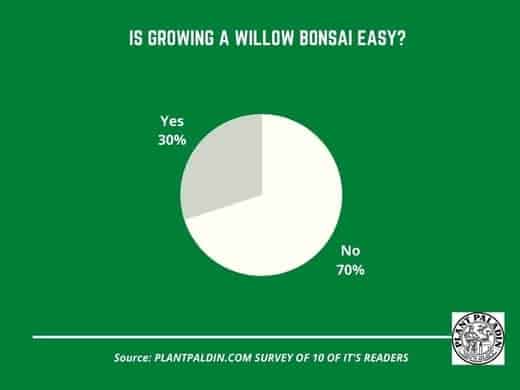
My top picks for the gear you will need!
So like I mentioned earlier, over the past three years of running PlantPaladin, hundreds of people have asked me for my recommendations on the best bonsai gear on the market.
Having spent thousands of dollars on bonsai items these past few years and tested at least 100 bonsai-specific products, I’ve listed my favorite products below – All of which I highly recommend and think you can get great value.
They can purchase directly by clicking the link to take them to Amazon.
Bonsai Tool Set: One of the significant challenges I’ve had is finding a toolset that was not only durable but didn’t break the bank. SOLIGT has recently developed a fantastic bonsai tool set that covers all the tools you need to trim, prune, and repot your trees. – You can grab it here.
Complete Bonsai Set: Many of you will want to grow your bonsai trees entirely from scratch, but finding the varicose seeds, pots, and other items in one place can be challenging. Leaves and Sole then have created a complete bonsai set that I’ve personally used that ticks all the boxes. You can grab it here.
Bonsai wire: The number of times I’ve run out of wire for my bonsai or purchased cheap bonsai wire that doesn’t do the job is embarrassing for me to admit. After a lot of trial and error, I found that using Hotop’s aluminum bonsai wire is one of the best options on the market. This can easily be used for both indoor and outdoor bonsai. You can grab it here.
This post was written by Fehed Nicass who has been passionate about bonsai for over 3 years. He currently resides in the UK and works in sales.

